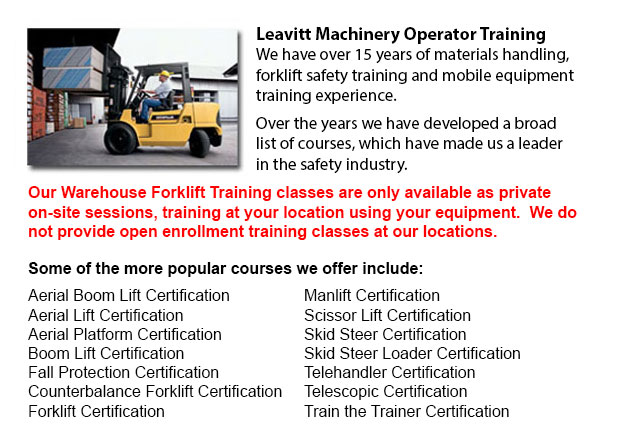
Guelph Warehouse Forklift Training Programs - Warehouses can be commercial, retail or industrial facilities. Their function could range from retailing bulk products to product distribution. Regardless of the kind of warehouse, staff inside warehouse settings should be well trained in safety procedures related to material handling and storage, conveyor systems, loading docks, and forklifts and pallet jacks. Good housekeeping is important to a safe and orderly warehouse setting.
Truck and loading dock systems are often located at a height from the ground. Products exit and enter warehouses through these systems where staff load and unload materials from ramps and elevated docks. Particular attention must be paid to safety habits during this stage. To prevent falls, install yellow striping along the edge of ramps and docks. Pay attention to the area around delivery trucks which are parked at the loading dock, particularly the area between dock and the truck. Be certain that truck wheels are chocked when unloading.
In order to distribute products in the facility, some warehouses make use of a conveyor system. These systems are designed with moving belts and wheels which can pose a pinch point hazard. Keep hair and parts of the body far away from conveyors to avoid injury. Elevated conveyors pose a hazard to workers under if safety nets are absent. Employees ought to know how to stop conveyors in case of emergency. Be aware of the location of emergency stop buttons and off switches. When servicing conveyors, tag out/lock out measures are mandatory.
Pallet jacks and forklifts are designed to move materials around the warehouse. Operators of forklifts are required to take training and be given certification. Pallet jack operators do not require certification, but should be trained on the equipment. Training programs instruct operators in the proper ways for lifting things and moving them to their assigned location. Neither forklifts nor pallet jacks should ever be used to lift or transport workers.
To allow for enough room for machines and people to pass, storage shelving and rack systems help to create an orderly and efficient work space, especially if they are correctly braced. Careful and slow placement of good is required to avoid accidents caused by products falling off the facing aisle. Aisles should be kept clear by keeping products flat and inside the shelving units. Pallets are used for stacking products. They should be in good condition, and palleted products must be shrink-wrapped or baled, whenever possible.
PPE or also referred to as personal protective equipment should be worn when required to help protect the employees' heads, limbs, feet and hands. Hard hats or bump caps, steel-toed shoes and gloves are common PPE.
Slippery floors that are pocked with pits and dents can present significant hazards, making good housekeeping extremely important. Warehouse floors and docks should be clear of debris oil and dirt. The space should be kept clear of boxes, baling supplies and garbage.
-
Guelph Warehouse Forklift Training Classes
Guelph Warehouse Forklift Training Classes - Warehouse training classes exist for the reason of raising awareness regarding common warehouse hazards. Students learn the important safety procedures that are necessary to warehouse safety. An emphasis i... More -
Guelph Forklift Operator Certification
Guelph Forklift Operator Certification - Certification for forklifts are needed to guarantee the safe use of forklifts for those employers in construction, industrial and warehouse settings. The training has to involve a method of education plus some... More -
Guelph Crane Training School
Guelph Crane Training School - The crane training school offers industry-relevant programs. Courses provide trainees with learning results that match current industry demands. Our small class sizes combine hands-on experience and theory. Our qualifie... More -
Guelph Heavy Equipment Training Programs
Guelph Heavy Equipment Training Programs - At whatever given construction site, there are usually various kinds of machines that are ready to be used. These heavy and light equipment need both operators to run them and mechanics to fix them. Apprenti... More -
Guelph Skid Steer Ticket
Guelph Skid Steer Ticket - On a skid-steer loader, the lift arms are at the side of the driver together with pivot points at the back of the driver's shoulders. This makes them different compared to a traditional front loader. Because of the operator... More -
Guelph Zoom Boom Ticket
Guelph Zoom Boom Ticket - Zoom Boom Training focuses on correctly training prospective operators on variable reach forklifts. The training goals include gaining the understanding of the equipments physics and to define the tasks of the operator. This... More -
Guelph Heavy Equipment Training
Guelph Heavy Equipment Training - Commonly, the different types of heavy equipment training are divided into 2 categories of machinery: those that have rubber tires and tracked vehicles. Tracked vehicles consist of items like for instance bulldozers,... More -
Guelph Aerial Lift Safety Training
Guelph Aerial Lift Safety Training - Each year, there are roughly 26 construction deaths due to the use of aerial lifts. Nearly all of the craftsmen killed are laborers, electrical workers, carpenters, painters or ironworkers. Nearly all deaths are c... More

Forklift Certification Guelph
TOLL FREE: 1-888-254-6157
Guelph, Ontario
forkliftcertificationguelph.com
Email Us
About Us


